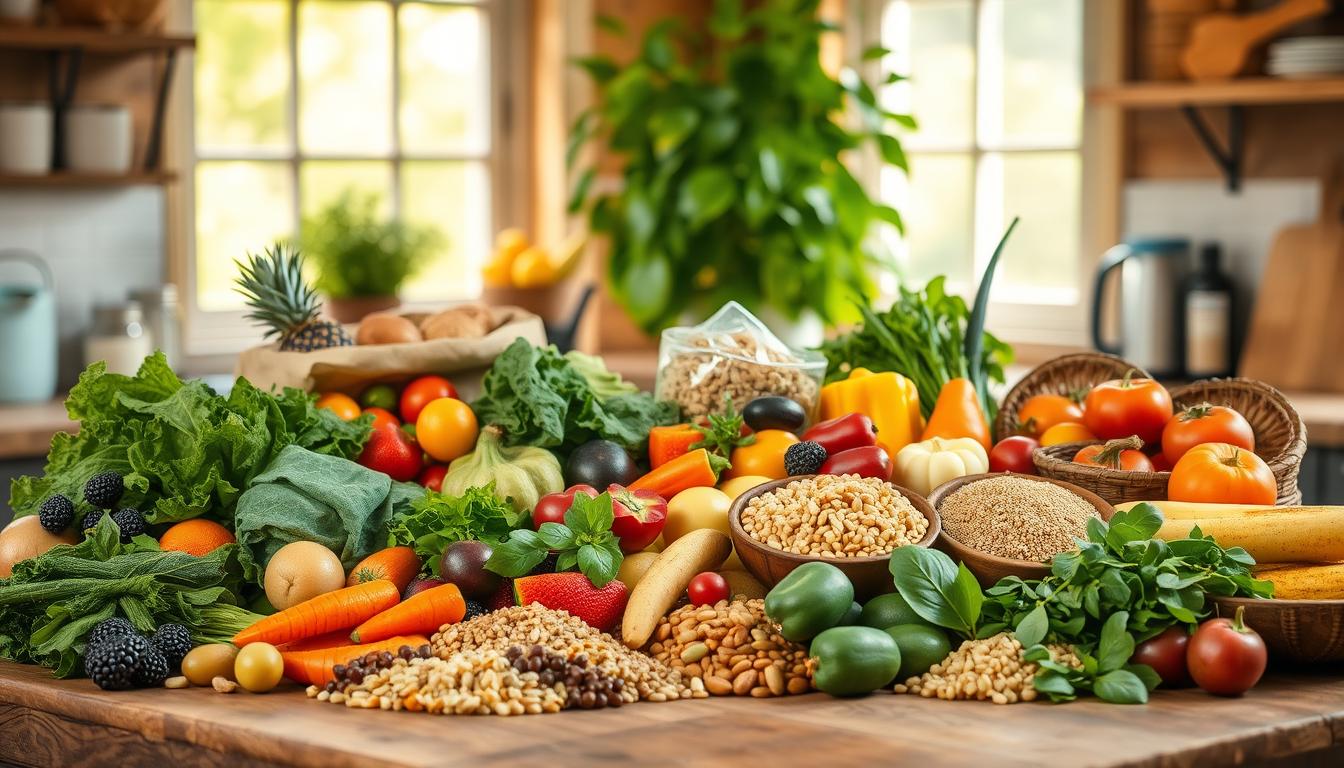Did you know that over 40% of Americans are actively trying to include more greens and grains in their meals? This shift isn’t just a trend—it’s a global movement. From environmental concerns to personal wellness, people are rethinking what’s on their plates.
The United Nations highlights that sustainable eating patterns can significantly reduce carbon footprints. Studies also show that choosing nutrient-rich options lowers risks of chronic illnesses. Brands like Beyond Meat and Impossible Foods are making it easier than ever to enjoy familiar flavors while embracing change.
This guide explores why so many are making the switch. Learn the benefits, practical tips, and how small changes can lead to big impacts—for you and the planet.
Introduction to Plant-Based Diets
Shifting toward whole-food choices doesn’t mean giving up all animal products. A plant-based diet focuses primarily on vegetables, fruits, and grains while allowing flexibility. This approach typically includes at least 80% plant-sourced foods, with room for occasional meat or dairy.

What Is a Plant-Based Diet?
Unlike strict regimens, this style emphasizes balance. Think lentils, quinoa, and leafy greens as staples, with eggs or fish appearing sparingly. Key nutrients like protein (from beans) and fiber (from whole grains) are prioritized.
How It Differs from Vegetarian and Vegan Diets
Here’s how they compare:
- Vegan: Excludes all animal products, including honey and gelatin.
- Vegetarian: Permits dairy and eggs but no meat.
- Flexitarian: Reduces meat without full elimination.
The WHO reports a 23% rise in global vegetarian and vegan populations since 2018. However, plant-based eating offers a middle ground for those not ready to cut out animal products entirely.
Why More People Are Choosing Plant-Based Diets
Health and environmental concerns are reshaping how millions choose their meals. Science and global data reveal compelling reasons to prioritize greens, grains, and legumes over traditional options.
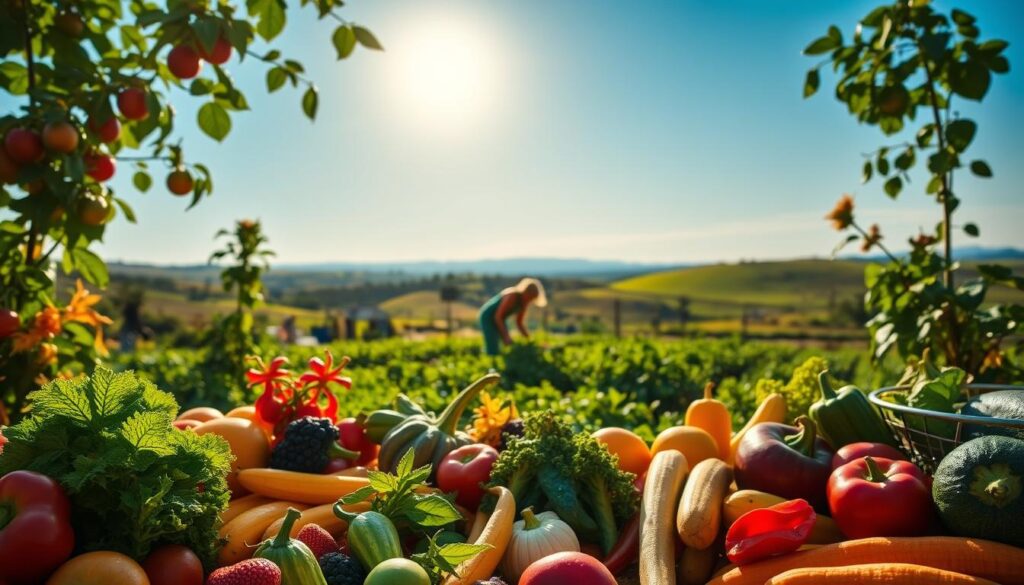
Health Benefits Driving the Trend
An NIH study found that diets rich in plants slash heart disease risk by 32%. Fiber-packed foods like beans and oats improve digestion, while antioxidants in berries combat inflammation.
Blue Zones research ties longevity to meals centered on vegetables and whole grains. Communities with the highest life spans consume minimal processed foods or animal products.
Environmental Concerns and Sustainability
Livestock farming generates 14.5% of global greenhouse gases, per the FAO. Switching to lentils saves 1,300 gallons of water per pound compared to beef.
Brands like Impossible Foods prove innovation can reduce emissions. Their products create 89% fewer emissions than traditional beef, according to lifecycle analyses.
Small swaps add up. Choosing peas over pork once a week cuts a household’s carbon footprint significantly.
The Rise of Meat Alternatives
Innovations in food technology are reshaping how we think about protein sources. Products like the Beyond Burger and Impossible Foods now mimic the taste and texture of animal-based foods, appealing to flexitarians and curious foodies alike.
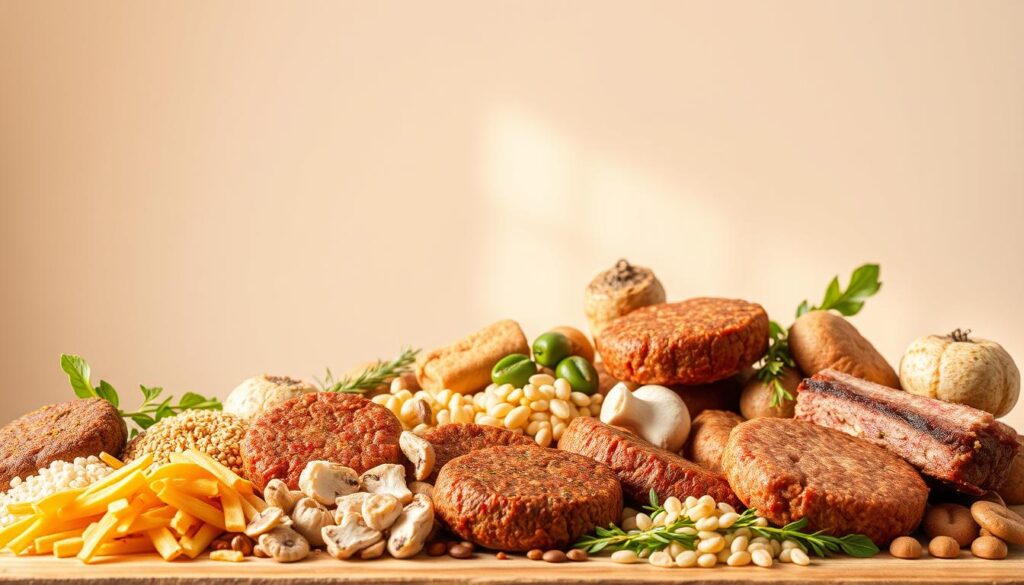
What Are Meat Alternatives?
These products replicate the sensory experience of meat using ingredients like pea protein or soy. Twin-screw extrusion—a process that layers plant proteins into fibrous textures—creates the “chew” of a burger or chicken strip.
Popular Types of Substitutes
Options vary by base ingredient and nutritional profile:
- Pea-protein burgers (Beyond Meat): 19g protein per patty, close to beef’s 20g.
- Mycoprotein (Quorn): Fermented fungi with a meat-like texture.
- Soy-based tempeh: Fermented whole beans with probiotics.
For those with allergies, brands like Daring Foods offer gluten-free chick’n made from legumes. The market now caters to nearly every dietary need.
Health Benefits of a Plant-Based Diet
The science behind nutrient-rich eating reveals powerful benefits for long-term wellness. Packed with fiber, antioxidants, and essential vitamins, these meals support everything from digestion to disease prevention.
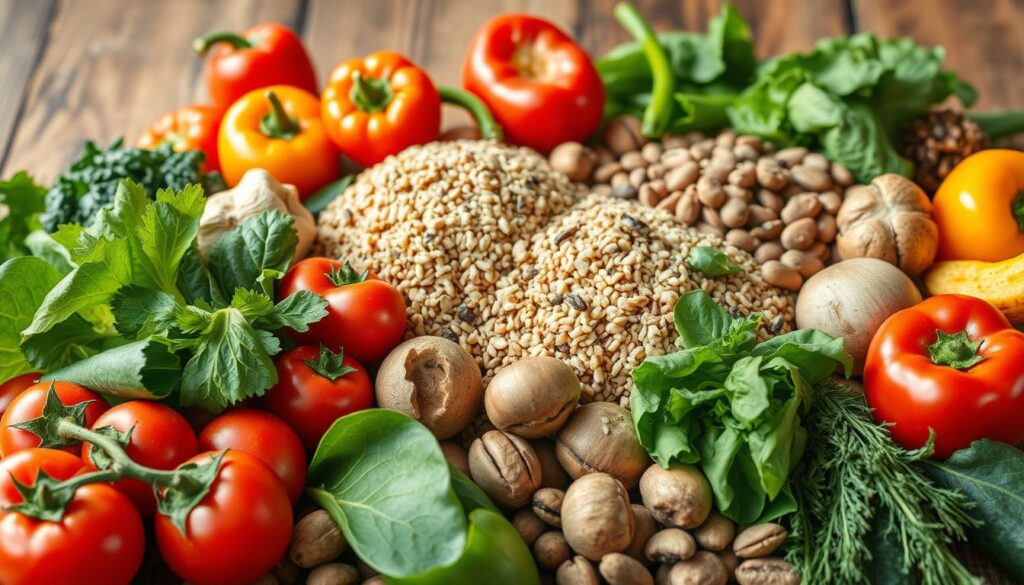
Nutritional Advantages Over Traditional Meals
Studies show that those prioritizing greens and grains consume 40% more fiber than average. This aids digestion and stabilizes blood sugar. For iron, pair lentils with vitamin C-rich foods like bell peppers to boost absorption.
Fortified options address gaps like B12, but watch for sodium in processed substitutes. Coconut oil in alternatives offers healthier fats than animal-based saturated fats.
Reduced Risk of Chronic Diseases
The Adventist Health Study-2 found a 75% lower diabetes risk among those avoiding animal products. Diets rich in plants also cut heart disease risks by nearly a third.
Balance is key. Opt for whole foods over ultra-processed substitutes to maximize health gains without excess salt or additives.
Environmental Impact of Plant-Based Diets
The way we eat directly shapes the planet’s future—every meal leaves a footprint. Choosing greens over animal products can slash resource demands and protect ecosystems. Let’s break down the numbers.

Lower Carbon Footprint
Animal agriculture is a top emitter. Producing 1kg of beef releases 60kg of CO2—equal to driving 150 miles. The same amount of tofu generates just 2kg. Switching proteins could cut global emissions by 8%.
| Food | CO2 Emissions (per kg) | Land Used (m² per 100g protein) |
|---|---|---|
| Beef | 60kg | 164m² |
| Tofu | 2kg | 8m² |
| Lentils | 0.9kg | 3m² |
Reduced Water and Land Usage
Beef needs 20x more land than beans for the same protein. Almond milk uses 130 gallons per gallon produced—dairy requires 1,000. Beyond Meat’s 2022 report shows their burgers use 99% less water than beef.
Deforestation ties closely to cattle ranching. 80% of Amazon clearing supports livestock. Brands like Miyoko’s Creamery partner with organic oat farms to promote regenerative agriculture.
Small swaps add up. Opting for peas instead of pork once a week saves 1,300 gallons of water annually. Sustainability starts on your plate.
Top Plant-Based Protein Sources
Protein-packed plants offer diverse options for every meal. Whether you’re cooking dinner or fueling workouts, these nutrient-rich foods deliver strength and flavor. Below are the best choices to meet your daily needs.
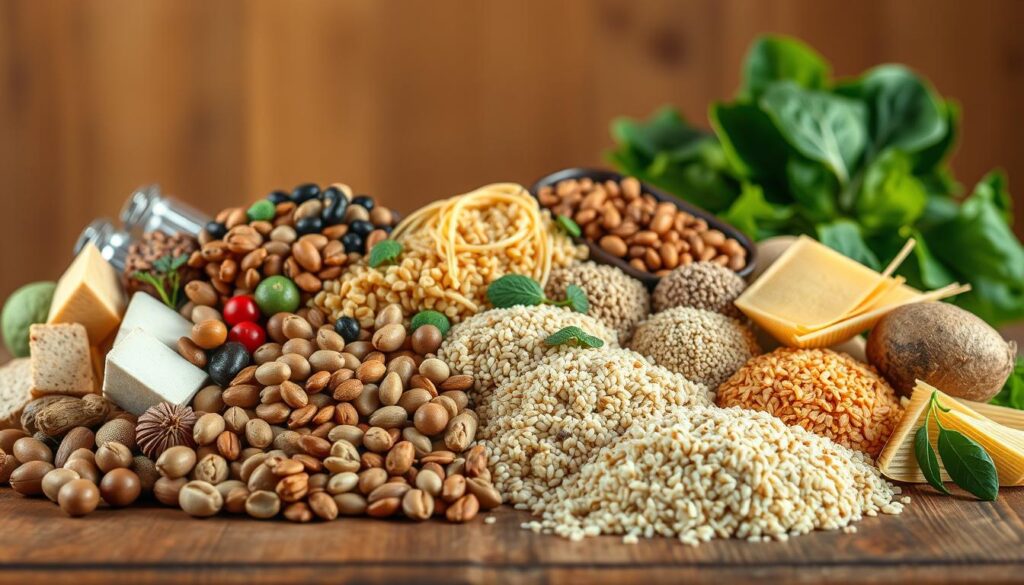
Legumes: Beans, Lentils, and Chickpeas
Legumes are protein powerhouses. A cup of lentils provides 18g of protein, while chickpeas offer 15g. Lupin beans, popular in Europe, pack 26g per cup—more than beef per serving.
Pair them with grains like quinoa for complete amino acids. Their high fiber content also supports digestion and heart health.
Soy Products: Tofu, Tempeh, and Edamame
Soy-based foods are versatile and rich in protein. Firm tofu contains 10g per ½ cup, and tempeh’s fermentation boosts B12 levels. For best texture, press tofu before cooking or marinate tempeh in apple cider vinegar.
Edamame, young soybeans, make a great snack with 17g protein per cup. They’re also rich in iron and calcium.
Pea Protein and Other Innovative Options
Pea protein shines in products like Ripple Foods’ milk (8g per serving). Water lentil (duckweed) powder is a newcomer with 80% protein content—ideal for smoothies.
| Protein Source | Protein per Serving | Key Benefit |
|---|---|---|
| Lentils | 18g/cup | High fiber |
| Tofu | 10g/½ cup | Versatile |
| Pea Protein | 8g/serving | Allergy-friendly |
Experiment with these options to discover new favorites. From stir-fries to shakes, plant proteins fit every craving.
Comparing Meat and Plant-Based Alternatives
Protein and iron content often spark debates between traditional and modern eating habits. While animal products dominate discussions, substitutes now rival their nutritional profiles—with some surprising twists.
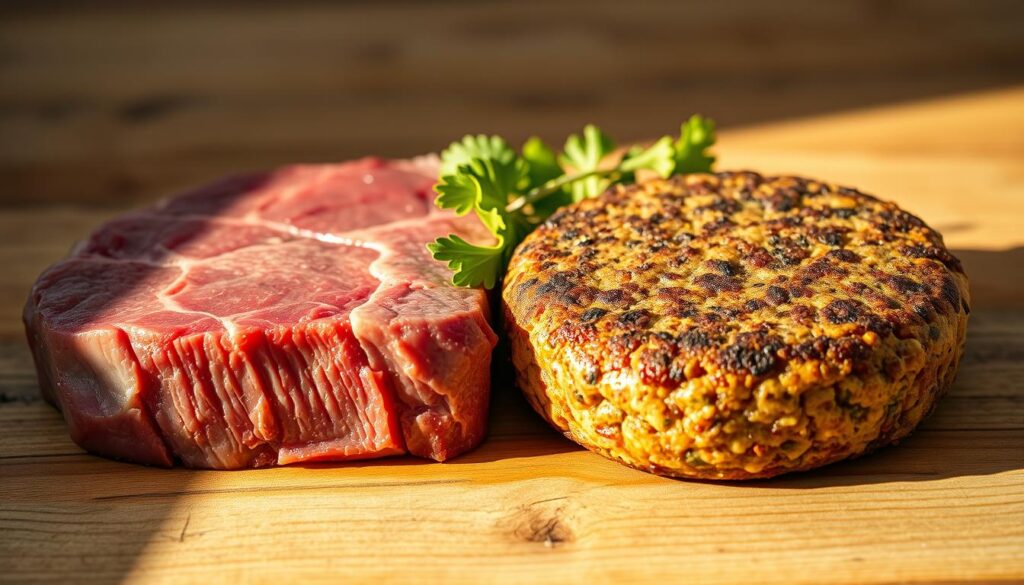
Nutritional Profiles: Protein, Iron, and More
Meat’s protein digestibility is 10–15% higher than plant-based options. Yet, 100g of spinach offers 2.7mg iron versus beef’s 2.6mg—though heme iron from meat absorbs more efficiently.
The “complete protein” myth fades when combining foods. Quinoa and black beans deliver all nine amino acids, matching meat’s profile. Fortified products like tempeh also close nutrient gaps.
Taste and Texture Differences
Blind tests show 68% couldn’t distinguish Impossible Burgers from beef. Shiitake mushrooms in No Evil Foods’ chorizo replicate umami, while pea protein mimics the chew of chicken.
Clean labels matter. Hilary’s veggie burgers use whole ingredients, unlike brands relying on methylcellulose. Texture innovations—like twin-screw extrusion—bridge the gap between expectations and reality.
Popular Plant-Based Meat Brands
From burgers to chick’n, modern food brands are redefining protein with plants. The market offers everything from juicy patties to crispy tenders, all without animal ingredients. Leading companies prioritize taste, nutrition, and sustainability.
Beyond Meat and Impossible Foods
Beyond Meat slashed saturated fat by 55% in its 2023 recipes, using avocado oil instead of coconut oil. Their pea-protein patties now grill like beef, sizzling with a meaty crust.
Impossible Foods stands out with soy leghemoglobin, an FDA-approved ingredient that mimics heme iron’s flavor. Their burgers bleed like beef, winning over skeptics.
Global and Niche Market Leaders
Other U.S. brands like Daring (legume-based chick’n) and Tofurky (artisanal deli slices) cater to diverse tastes. In Europe, Spain’s Heura uses olive oil for Mediterranean flair, while the Netherlands’ Vivera supplies 20+ countries.
Niche players shine too. Atlas Monroe won VegNews’ 2023 “Best in Show” for fried chik’n, proving indulgence needs no compromise.
| Brand | Key Product | Price (USD) |
|---|---|---|
| Gardein | Ultimate Beefless Burger | $4.99/12 oz |
| MorningStar Farms | Spicy Black Bean Burger | $3.99/10 oz |
| Lightlife | Smart Dogs | $4.49/12 oz |
Prices vary, but sales often drop costs to parity with meat. Whether you crave smoky ribs or spicy sausage, there’s a plant-powered option waiting.
How to Transition to a Plant-Based Diet
Making changes to your eating habits doesn’t have to be overwhelming—small steps can lead to lasting results. Start with simple swaps or structured plans, depending on your comfort level. Here’s how to make the shift seamless and sustainable.
Gradual vs. Immediate Shifts
A slow approach works for many. Try Meatless Mondays or replace breakfast meats with tofu scramble. Over 30 days, gradually increase greens and legumes.
For a faster transition, use the USDA MyPlate method:
- 50% non-starchy vegetables (spinach, broccoli)
- 25% whole grains (quinoa, brown rice)
- 25% protein-rich plants (lentils, chickpeas)
Meal Planning and Preparation Tips
Batch-cook staples like quinoa or roasted chickpeas for quick meals. Freeze chopped greens to reduce waste. Meal kits like *Purple Carrot* offer pre-portioned recipes for beginners.
Don’t forget nutrition gaps:
- Add nutritional yeast (3μg B12/tbsp) to soups or popcorn.
- Pair iron-rich beans with vitamin C (bell peppers) for better absorption.
With these strategies, every meal becomes a step toward better health—and a lighter footprint.
Budget-Friendly Plant-Based Eating
Eating well doesn’t have to break the bank—smart choices keep costs low and nutrition high. Prioritizing staples like beans and grains slashes grocery bills while delivering protein and fiber.
Affordable Protein Sources
Black beans cost just $0.15 per serving—90% less than beef. Dry lentils ($1.29/lb) are cheaper than canned but equally versatile. Bulk bins at stores like WinCo offer rice for $0.50/lb, cutting costs further.
Frozen veggies retain nutrients at 30% lower prices. Spinach, peas, and mixed blends work in soups, stir-fries, or smoothies without sacrificing quality.
Reducing Costs Without Sacrificing Nutrition
DIY seitan costs $5 for 10 servings using vital wheat gluten. Asian markets sell 25-lb rice sacks for $15, a year’s supply for families.
Farmers’ markets often accept SNAP, doubling purchasing power. Seasonal produce like squash or sweet potatoes maximizes value and flavor.
| Item | Cost | Savings Tip |
|---|---|---|
| Dry Black Beans | $1.29/lb | Soak overnight to reduce cook time |
| Frozen Broccoli | $1.50/12 oz | Buy store brands for 20% less |
| Brown Rice | $0.50/lb (bulk) | Cook in batches, freeze portions |
Common Myths About Plant-Based Diets
Protein concerns and flavor myths often hold people back from exploring new food choices. Let’s separate fact from fiction with science and real-world examples.
Protein Deficiency Isn’t Inevitable
Well-planned meals easily meet protein needs. Lentils, quinoa, and tofu provide all nine amino acids, debunking the “incomplete protein” myth. The Academy of Nutrition and Dietetics confirms balanced vegetarian diets support all life stages.
Strength isn’t sacrificed either. Patrik Baboumian, a vegan strongman, set a world record by deadlifting 1,190 pounds. His diet? Beans, nuts, and fortified grains.
Flavor and Satisfaction Can Thrive
Bland meals are a choice, not a requirement. Smoked paprika, miso paste, and liquid smoke add depth to dishes. A 2023 JAMA study found no difference in bone density between vegan and omnivore athletes—proof that taste and nutrition coexist.
Brands like Oatly tackle dairy myths head-on. Their “Help Dad” campaign highlights how oat milk matches dairy’s creaminess without downsides.
| Protein Source | Protein per Serving | Key Benefit |
|---|---|---|
| Lentils | 18g | High in iron |
| Tempeh | 15g | Probiotics |
| Pea Protein | 8g | Allergy-friendly |
Dispelling these myths opens doors to healthier, sustainable eating—without compromise.
Plant-Based Diets for Athletes
Elite athletes are proving that performance thrives without animal products. From NFL players to Olympic cyclists, plant-powered protein fuels record-breaking results. Science backs this shift—studies show pea protein aids muscle recovery as effectively as whey.
Meeting Protein and Energy Needs
Strength athletes need ~1.6g protein per kg of body weight. Lentils and rice combine to form complete amino acids, rivaling meat’s profile. For endurance, carb-load with sweet potatoes (slow-release energy) instead of processed pasta.
| Protein Source | Protein per Serving | Best For |
|---|---|---|
| Pea Protein | 24g/scoop | Post-workout recovery |
| Tempeh | 15g/½ cup | Meal prep (stir-fries) |
| Quinoa | 8g/cup | Pre-race fuel |
Success Stories from Plant-Based Athletes
NFL’s Cam Newton starts his day with a 40g plant-based protein scramble. Track cyclist Dotsie Bausch won silver at 39, crediting lentils and leafy greens. Brands like Gainful customize vegan supplements for individual needs.
“Plants gave me stamina meat never could,” says Bausch. Her training plate? 50% greens, 30% grains, 20% legumes—a blueprint for peak performance.
Kids and Plant-Based Diets
Raising kids on nutrient-rich meals doesn’t mean sacrificing taste or health. With careful planning, children get all the vitamins and minerals they need to grow strong. The AAP recommends regular blood tests to monitor iron and zinc levels, especially for families avoiding animal products.
Ensuring Proper Nutrition for Growing Children
Fortified foods play a big role. Almond milk provides 45% of daily calcium needs per cup, while nutritional yeast adds B12. For protein, blend beans into smoothies or bake them into brownies.
Key tips for balanced nutrition:
- Pair iron-rich lentils with vitamin C (like oranges) to boost absorption.
- Use Serenity Kids’ toddler pouches for convenient, veggie-packed snacks.
- Opt for whole-grain Banza pasta in mac & cheese—sneak in puréed squash.
Kid-Friendly Plant-Based Recipes
Turn picky eaters into veggie lovers with these ideas:
- Banana pancakes: Blend spinach into the batter for hidden greens.
- Chickpea nuggets: Crushed cereal adds crunch without frying.
- School lunches: Swap PB&J for sunflower seed butter and apple slices.
With creativity, every meal can be both nutritious and fun. Start small—even one plant-based food swap a day makes a difference.
Eating Out on a Plant-Based Diet
Dining out doesn’t mean compromising your food choices—today’s restaurants cater to diverse preferences. Whether it’s a quick bite or a sit-down meal, flavorful options abound.
Navigating Restaurant Menus
Scan menus for keywords like “vegetable-forward” or “plant-powered.” Many chains now label dishes clearly. At The Cheesecake Factory, the Vegan Cobb Salad with Beyond Meat packs 21g protein.
Customize orders effortlessly. Swap cheese for avocado in Mexican food or ask for tofu instead of chicken in Thai curries. Apps like HappyCow help travelers find top-rated spots globally.
Fast Food and Chain Restaurant Options
Fast food giants are joining the trend. Burger King’s Impossible Whopper mirrors the classic’s taste, while Chipotle’s Sofritas (150 calories/serving) spice up bowls.
Starbucks’ Chickpea Bites & Avocado Protein Box offers a balanced on-the-go meal. Even pizza chains like Domino’s test vegan cheese in select markets.
| Restaurant | Top Pick | Nutrition Highlights |
|---|---|---|
| Chipotle | Sofritas Bowl | 15g protein, 5g fiber |
| Panera Bread | Mediterranean Veggie Sandwich | No dairy, 13g protein |
| Subway | Veggie Delite | Customizable, 9g protein |
Pro tip: Call ahead for hidden gems. Italian spots often veganize eggplant parm, and diners may offer tofu scrambles.
Delicious Plant-Based Recipes to Try
Craving quick, tasty meals? These recipes prove healthy eating can be effortless. Whether you’re a busy parent or a meal-prep pro, these ideas balance flavor and nutrition. Challenge yourself to include 30 different plant-based foods weekly—it’s easier than you think!
Easy Weeknight Dinners
Short on time? Whip up these crowd-pleasers:
- Lentil walnut taco “meat”: Ready in 30 minutes, costs just $1.50 per serving. Top with avocado for extra creaminess.
- Jackfruit pulled “pork” sandwiches: Instant Pot-friendly and packed with fiber. Serve on whole-grain buns.
- Freezer-friendly black bean enchiladas: Batch-cook for future meals. Use corn tortillas for a gluten-free option.
Hearty and Flavorful Breakfast Ideas
Start your day strong with these protein-rich options:
- Chickpea flour omelette: Turmeric adds color and anti-inflammatory benefits. Stuff with spinach and mushrooms.
- Aquafaba chocolate mousse: Whip chickpea brine into a decadent dessert. Top with fresh berries.
- Tofu scramble: Season with cumin and nutritional yeast for a cheesy twist. Pair with sweet potato hash.
Conclusion: Embracing the Plant-Based Movement
The future of food is evolving—more greens, less waste, and smarter choices. Today, 6% of Americans avoid animal products, up from just 1% in 2014. This shift isn’t slowing down; experts project 15% annual market growth for alternatives through 2030.
According to the UNEP, prioritizing plants could cut food-related emissions by 70%. Innovations like Revo Foods’ 3D-printed salmon prove sustainability and flavor coexist. Even small steps matter—try one plant-based food meal weekly using our recipes.
As Michael Pollan wisely said, “Eat food. Not too much. Mostly plants.” Whether for health or the planet, every plate is a chance to shape a better future.
